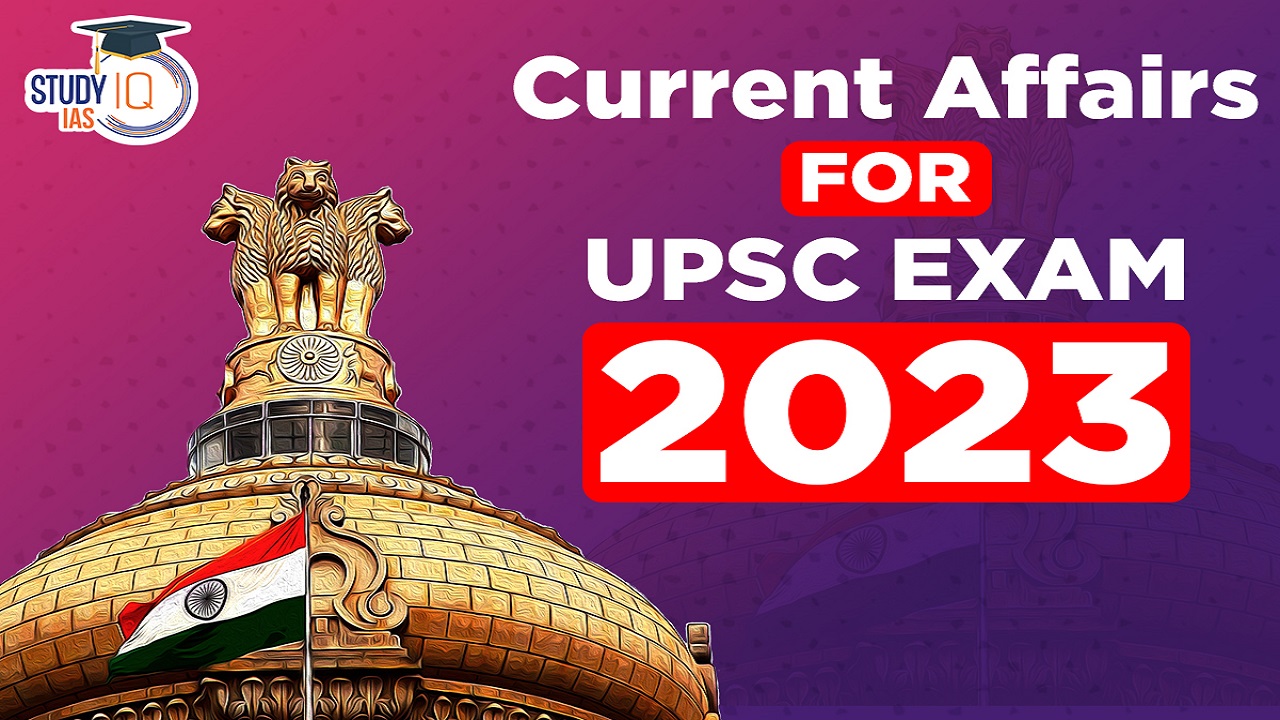Current Affairs 7th July 2023 for UPSC Prelims Exam
Remission
Context: The Supreme Court has sentenced four men found guilty in the 1996 Lajpat Nagar blast case to imprisonment for life without remission.
What is Remission?
- Definition: In remission, the duration of the sentence is reduced, without changing the nature of the sentence.
- Remission and suspension differ to a large extent. In remission, the nature of the sentence is remained untouched while the duration is reduced i.e., the rest of the sentence need not be undergone.
- The effect of the remission is that the prisoner is given a certain date on which he shall be released and in the eyes of the law he would be a free man.
- However, in case of breach of any of the conditions of remission, it will be cancelled, and the offender has to serve the entire term for which he was originally sentenced.
- Right to Remission: The Remission system has been defined under the Prison Act, 1894 to be a set of rules formulated for the time being in force regulating the award of marks to, and the consequent shortening of sentence of, prisoners in Jail.
- It is an important aspect of the reformation and retribution principle of the criminal justice system that modern liberal democracies like India have long thrived for.
- It was observed in the Kehar Singh vs. Union of India (1989) case that Courts cannot deny to a prisoner the benefit to be considered for remission of sentence, as by doing so the prisoner would have to live in the prison till his/her last breath without there being a ray of hope to be free again.
- This would not just be against the principles of reformation but will also push the convict into a dark hole without there being a semblance of light at the end of the tunnel.
- The Supreme Court in State of Haryana vs. Mahender Singh and Others (2007) case observed that even though no convict has a fundamental right of remission or shortening of sentence, but the State in exercise of its executive power of remission must consider each individual case keeping in view the relevant factors.
- Further, the Court was also of the view that a right to be considered for remission, keeping in view the constitutional safeguards for a convict covered under Articles 20 and 21 of the Constitution, must be held to be legal one.
- Constitutional Provisions:
- Both the President and the Governor have been vested with sovereign power of pardon by the Constitution.
- Under Article 72, the President can grant pardons, reprieves, respites or remissions of punishment or suspend, remit or commute the sentence of any person.
- This can be done for any person convicted of any offence in all cases where:
- the punishment or sentence is by a court-martial, in all cases where the punishment or
- sentence is for an offence under any law relating to the Union government’s executive power, and in all cases of death sentences.
- Under Article 161, a Governor can grant pardons, reprieves, respites or remissions of punishment, or suspend, remit or commute the sentence.
- This can be done for anyone convicted under any law on a matter which comes under the State’s executive power.
- Statutory Power of Remission: Sections 432 and 433 of the Code of Criminal Procedure, 1973 prescribes a procedure in which the process of remission must be conducted by the appropriate Government.
- Under Section 432, the ‘appropriate government’ may suspend or remit a sentence, in whole or in part, with or without conditions.
- Under Section 433, any sentence may be commuted to a lesser one by the appropriate government. This power is available to State governments so that they may order the release of prisoners before they complete their prison terms. But the exercise of this power is subject to judicial review.
- Statutory Power of Remission Vs. Constitutional Power of Remission: Even though they appear similar, the power of remission under the CrPC is different from the constitutional power enjoyed by the President and the Governor.
- Under the CrPC, the government acts by itself.
- Under Article 72 and Article 161, the respective governments advise the President/Governor to suspend, remit or commute sentences.
- Despite the fact that it is ultimately the decision of the government in either case, the Supreme Court has made it clear that the two are different sources of power.
- In Maru Ram etc. vs Union of India (1980), the Supreme Court said: “Section 432 and Section 433 of the Code are not a manifestation of Articles 72 and 161 of the Constitution but a separate, though similar, power.”
Current Affairs 6th July 2023 for UPSC Prelims Exam
The Jagannath Temple
Context: The Jagannath Temple rath yatra has just been concluded in Odisha.
About Jagannath Temple
- Definition: Odisha is known as the land of Lord Jagannath (literally meaning the Lord of the Universe).
- The Jagannath Temple at Puri is one of the most revered Vaishnava sites of worship in India.
- It is one of the Dhamas (Holiest of the holy place) out of four Dhamas i.e., Puri, Dwarika, Badrinath & Rameswar, in India.
- It is one of the oldest Hindu temples to still be in use, its main shrine was built by Anantavarman of the Chodaganga dynasty in the 10th century.
- About 70-80% of the people in the town are dependent on the temple’s economy.

- Deities: Mahaprabhu Shri Jagannath along with sister Devi Subhadra and elder brother Mahaprabhu Shri Balabhadra are worshipped at the temple.
- Features: The main temple is constructed in such a way that no shadow of the temple falls on the ground at any time of the day.
- The Nilachakra – Or the Blue wheel perched on top of the temple is made of eight metals or asta dhatu. It is believed that if you see the Nilachakra it is as good as seeing the Lord himself.
- The flag or the Patitapabana flows in the opposite direction of the wind and is changed every day at sunset and is changed every day.
- The feet of changing the flag’s rests with a family appointed by the King. They have been doing this ritual for over 800 years, climbing 165 meters, bare feet without any support.
- The Aruna stambha– the 33 ft monolith structure pillar in front of the Singhadwar or the main entrance of the temple was originally located at the Sun Temple, Konark.
- Another unique feature of the temple is that the idols of the holy trinity are carved out of wood rather than stone or metal idols. They are also the only deity with the trappings of mortality.
- The temple was in the 19th century, recognised by European sailors as the “white pagoda”.
- Festivals: There are many festivals and rituals associated with the Lord, we list a couple.
- Devasnana Purnima: the annual bathing ritual, where the holy trinity has brought out from their sanctum on seated in a raised platform and bathed with purified water drawn from a well within the temple premises.
- Chariot Festival: This happens during the month of June/July. During the festival, the Lord comes out to the street to greet his devotees, people irrespective of caste, creed & colour can seek his blessings.
Puri Heritage Corridor Project
- It is a redevelopment project of the Odisha government in Puri to create an international heritage site, including the Jagannath temple. Though conceived in 2016, it was unveiled in December 2019.
- Under the umbrella project falls the Shree Jagannatha Heritage Corridor (SJHC) or the Shree Mandira Parikrama Project, for the revamp of the area around the temple.
- The project also includes the Shree Jagannath Temple Administration (SJTA) building redevelopment, a 600-capacity Srimandir reception centre, Puri Lake, Musa River revival plan, etc.
- The State government allotted funds for the Project from its Augmentation of Basic Amenities and Development of Heritage and Architecture at Puri (ABADHA) scheme.
- The ABADHA scheme includes Land Acquisition Charges/Re-habitation& Resettlement/ Road Improvement for providing better facilities in & around Shree Jagannath Temple.
Competition Commission of India (CCI)
Context: Google has accused CCI of ordering changes to its business model “only to protect” rival Amazon.
More on News
- The CCI had found Google to have allegedly abused its dominant position in contravention of the Competition Act, 2002.
- It had penalized Google and asked it to pay Rs 1,337.76 crore for practices related to Android devices.
- CCI also ordered the tech giant to cease and desist from various “unfair business practices” and allow modified versions of its Android operating system, called Android fork.
- Google, in its latest appeal to the Supreme Court, has said the CCI is protecting Amazon’s interests after having complained that CCI had copied part of a European Commission ruling against it for allegedly abusing the market dominance of Android.

About Competition Commission of India (CCI)
- Definition: The Competition Commission of India (CCI) is a statutory body.
- It was established in 2009 by Government of India under the Competition Act, 2002 for the administration, implementation, and enforcement of the Act.
- It should be noted that on the recommendations of Raghavan committee, the Monopolies and Restrictive Trade Practices Act, 1969 (MRTP Act) was repealed and replaced by the Competition Act, 2002.
- CCI is a quasi-judicial body.
- It was established in 2009 by Government of India under the Competition Act, 2002 for the administration, implementation, and enforcement of the Act.
- Objectives:
- Eliminate practices having adverse effect on competition.
- Promote and sustain competition.
- Protect the interests of consumers.
- Ensure freedom of trade in the markets of India
- Proactive engagement with all stakeholders, including consumers, industry, government and international jurisdictions.
- Being a knowledge intensive organization with high competence level
- Professionalism, transparency, resolve and wisdom in enforcement.
- Composition: CCI consists of a chairperson and 6 Members appointed by the Central Government.
- Significance: CCI has adjudicated more than 1,200 antitrust cases that were highly complex, traversed till the apex court and stood the judicial scrutiny, and in the process, developed world-class jurisprudence.
- It has also reviewed more than 900 mergers and acquisitions till date, cleared most of them, within a record average time of 30 days.
- CCI has also come up with several innovations like the ‘green channel’ provision for automated approval on combinations and cleared more than 50 of such transactions.
- CCI has conducted several market studies helping dynamics of market.
- CCI has slapped hefty fines on tech giant Google, and hospitality firms like OYO and MakeMyTrip.
- Challenges:
- Toothless Regulator: CCI has been called a ‘Toothless regulator’ by critics as most of the orders of the CCI are under appeal before the National Company Law Appellate Tribunal (NCLAT) or under challenge in the high courts or the Supreme Court.
- Threat from Cartelization: The Union Government is pushing infrastructure growth to scale up demand, hence there is a possibility of threat from cartelisation.
- Input costs are rising despite India having a huge capacity to cater to both domestic and export demands.
- There is a global shortage of commodities due to the pandemic and war in Eastern Europe, hence, the supply chain has been adversely affected.
- There is a need to ensure that there are no monopolistic/duopolistic tendencies leading to price rise and supply side manipulations.
- Regulatory Overlap: In spheres such as telecom, internet and big-technology, CCI’s functions also overlap with other regulatory bodies such as the Telecom Regulatory Authority of India (TRAI).
- Lack of Technical Staff: CCI will require staff with specialized knowledge in technology as well as an understanding of modern industrial economics.
- Lack of Digitization: There is lack of new market definition for digital technologies.
- With the advent of Web 3.0, AI, IoT, Blockchain and other technological developments, and emergence of issues like data protection and privacy, search bias, platform neutrality, deep discounting, hostile takeovers, confidentiality, etc, the need for a robust competition law, geared to meet the needs of present day techno-legal world becomes vital.
What is the Competition Act?
- The Competition Act, 2002, as amended by the Competition (Amendment) Act, 2007, follows the philosophy of modern competition laws.
- The Act prohibits anti-competitive agreements, and abuse of dominant position by enterprises and regulates combinations (acquisition, acquiring of control and M&A), which causes or likely to cause an appreciable adverse effect on competition within India.
- In accordance with the provisions of the Amendment Act, the Competition Commission of India and the Competition Appellate Tribunal have been established.
- The Government of India replaced Competition Appellate Tribunal (COMPAT) with the National Company Law Appellate Tribunal (NCLAT) in 2017.
- The provisions of the Competition Act relating to anti-competitive agreements and abuse of dominant position were notified on May 20, 2009.
EU’s Carbon Border Adjustment Mechanism
Context: The EU’s introduction of a Carbon Border Adjustment Mechanism (CBAM) could impede India’s exports of steel, iron ore and cement.
What is Carbon Border Adjustment Mechanism (CBAM)?
- In April, the EU approved the world’s first plan to impose a levy on high-carbon goods imports from 2026, aiming to become a net zero emitter of greenhouse gases by 2050.
- It is a proposed policy that would place a price on the carbon content of certain imported goods.
- It’s a type of carbon pricing mechanism designed to prevent carbon leakage, which occurs when companies move their operations to countries with weaker climate policies in order to avoid carbon pricing or other climate regulations.
- Need for CBAM:
- In 2005, the EU has implemented the Emissions Trading System (ETS) to regulate greenhouse gas emissions within its borders.
- However, the EU fears that industries in other countries with less stringent emission regulations may have a competitive advantage over EU industries, leading to carbon leakage.
- To address this issue and level the playing field, the CBAM is proposed.
- It aims to ensure that imported goods from countries with lax carbon pricing policies bear similar economic costs as EU-produced goods covered by the ETS.
- CBAM was legislated as part of the European Green Deal, it takes effect in 2026, with reporting starting in 2023.
- The European Green Deal, approved in 2020, is a set of policy initiatives by the European Commission with the overarching aim of making the EU climate neutral in 2050.
- Reporting of carbon content in exports to the EU would be required beginning Oct. 1, 2023, and the main goods affected would be steel, cement, aluminium, fertilisers, electricity and hydrogen.
How will the CBAM Work in Practice?
- Companies that want to import goods produced outside the EU into the EU will have to purchase certificates corresponding to the amount of emissions generated in the production of those goods.
- The European Commission will calculate the price of CBAM certificates to reflect the average weekly price of ETS auctions.
- This means that CBAM certificates will be pegged to the ETS. This will ensure that the price of CBAM certificates is as close as possible to the price of ETS allowances while also ensuring that the system remains manageable for the administrative authorities.

Which Sectors and Emissions are Covered by CBAM?
- Initially, CBAM will cover direct emissions (scope 1) of selected sectors: iron and steel, cement, aluminum, fertilizers and electricity.
- The greenhouse gas emissions regulated by the CBAM correspond to those emissions covered by Annex I to the EU ETS, namely carbon dioxide (CO2) as well as, where relevant, nitrous oxide (N2O) and perfluorocarbons (PFCs).
- Indirect emissions (scope 2) will not be covered in the initial phase but can be added after the transitional period.
What are India’s Concerns about the EU’s CBAM?
- India is Europe’s third-largest trading partner, and it does not have its own carbon tax or cap. So, CABAM is a cause of concern for India.
- Important to note, countries in the EU combined represent about 14% of India’s export mix for all products, steel and aluminum included.
- Given India’s products have a higher carbon intensity than its European counterparts, the carbon tariffs imposed will be proportionally higher making Indian exports substantially uncompetitive.
- A UNCTAD study predicts that India will lose $ 1-1.7 billion in exports of energy-intensive products such as steel and aluminum.
- India’s exports are likely to be hit by the European Union’s 20% to 35% tariffs on high-carbon goods like steel, iron ore and cement amid already subdued demand from developed nations.
- While India’s exports may be limited to aluminum, iron, and steel, and affect only 1.8% of its total exports to the EU, India has reportedly decried CBAM as being protectionist and discriminatory.
- There is also talk of challenging the CBAM at the World Trade Organization (WTO)’s dispute settlement body.
FDI and FPI
Context: Gross inward foreign direct investment (FDI) in FY23 declined 16.3 per cent on a year-on-year basis to $71 billion from $84.8 billion in FY22.
About Foreign Direct Investment (FDI)
- FDI refers to the investment made by individuals, companies, or governments from one country into businesses or assets located in another country.
- In FDI, the investor acquires a lasting interest in an enterprise operating in a foreign country.
- FDI can involve establishing a new business, merging with an existing business, or acquiring shares in a foreign company.
- FDI plays a significant role in the global economy as it facilitates the flow of capital, technology, and expertise between countries.
- The Department for Promotion of Industry and Internal Trade (DPIIT) under the Ministry of Commerce and Industry, is the nodal department for the formulation of the Government’s policy on Foreign Direct Investment (FDI).
- Routes through which India gets FDI:
- Automatic Route: In this, the foreign entity does not require the prior approval of the government or the RBI.
- Government route: In this, the foreign entity has to take the approval of the government.
- DPIIT is the administrative ministry for FDI proposals by Non-Resident Indians (NRl)/ Export Oriented Units (EOU’s) requiring approval of the Government.
- FDI proposals involving total foreign equity inflow of more than Rs 50 billion, are referred to Cabinet Committee on Economic Affairs (CCEA).

About Foreign Portfolio Investment (FPI)
- FPI refers to the investment in financial assets, such as stocks, bonds, or other securities, by individuals, institutional investors, or funds from one country into another country.
- Unlike (FDI), which involves a long-term and direct ownership stake in a foreign business or asset, FPI involves the purchase of financial instruments for the purpose of earning short-term financial returns.
- FPI Investors do not have direct control or management influence over the underlying companies or assets. Instead, they seek capital gains, dividends, or interest income from their investments.
- In India, foreign portfolio investment is regulated by the Securities and Exchange Board of India (SEBI).
- According to the present FPI policy, investment up to 10% shareholding by a single foreign investor in an Indian firm is FPI. More than 10% shareholding will be considered as FDI. This differentiation between FDI and FPI is needed for regulatory purposes.


 Kailash Mansarovar Yatra to Resume Soon,...
Kailash Mansarovar Yatra to Resume Soon,...
 What is Tensor Processing Unit (TPU)?
What is Tensor Processing Unit (TPU)?
 SSC CGL Syllabus 2025 for Tier 1 and Tie...
SSC CGL Syllabus 2025 for Tier 1 and Tie...





















